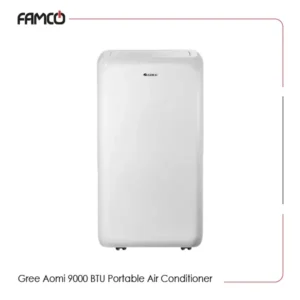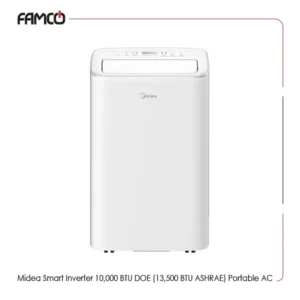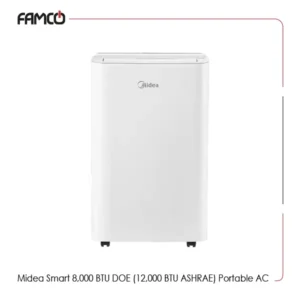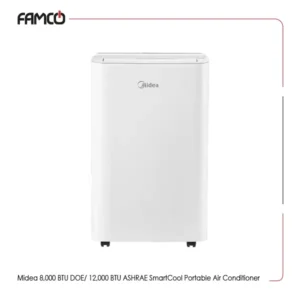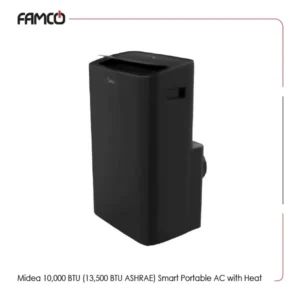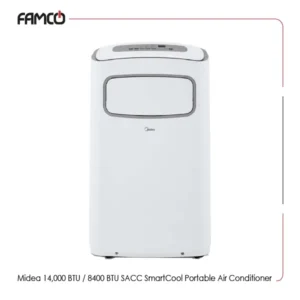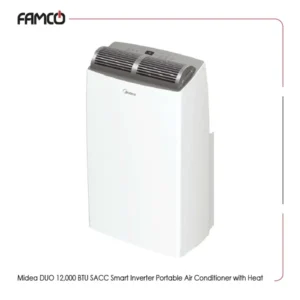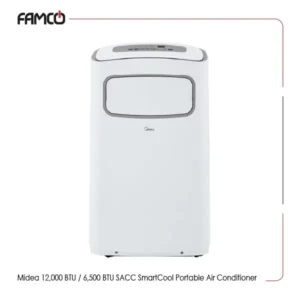Transform your summers with our portable air conditioner, the ultimate solution for instant cooling wherever you go. Say goodbye to sweltering heat and hello to comfort on demand. Experience cooling convenience like never before.
Types of Portable Air Conditioner
Portable air conditioners come in various types to suit different needs and preferences. Here are some common types:
- Single-Hose Portable Air Conditioners: These units have a single exhaust hose. They draw warm air from the room, cool it, and then expel the hot air outside through the same hose. While they are generally more affordable, they may be less efficient because they create negative pressure in the room, which can pull in warm air from other areas.
- Dual-Hose Portable Air Conditioners: These models have two hoses: one for intake (drawing in warm air) and another for exhaust (expelling hot air). Dual-hose units are more efficient because they don’t create negative pressure. They maintain a better balance between cooling and ventilation, making them suitable for larger rooms or spaces.
- Portable Air Conditioner with Heat Pump: Some portable AC units come with a heat pump feature, allowing them to provide both cooling and heating functions. These units are versatile and suitable for year-round use, providing comfort in both hot summers and chilly winters.
- Smart Portable Air Conditioners: These units come with smart features such as Wi-Fi connectivity and compatibility with voice assistants. Users can control them remotely through a smartphone app, set schedules, and adjust settings with ease, offering convenience and flexibility.
- Compact Portable Air Conditioners: Designed for smaller spaces or for portability, compact portable AC units are lightweight and easy to move around. They are ideal for cooling specific areas such as bedrooms, offices, or small apartments.
- Quiet Portable Air Conditioners: These units are engineered to operate quietly, making them suitable for bedrooms, offices, or any space where noise level is a concern. They provide cooling without disturbing your peace and quiet.
Portable Air Conditioning Components
Portable air conditioners typically consist of several key components that work together to provide effective cooling as one kind of split systems types. Here are the main components:
- Compressor: The compressor is the heart of the air conditioning system. It compresses and circulates refrigerant gas, which absorbs heat from the indoor air.
- Evaporator Coil: The evaporator coil is located inside the unit and is responsible for absorbing heat from the indoor air. As refrigerant passes through the coil, it evaporates and cools the air before circulating it back into the room.
- Condenser Coil: The condenser coil is located outside the unit and is responsible for releasing heat absorbed from the indoor air. As refrigerant passes through the coil, it condenses back into a liquid, releasing heat to the outdoor air.
- Refrigerant: Refrigerant is the substance used to transfer heat between the indoor and outdoor coils. It changes from a liquid to a gas and back again as it absorbs and releases heat.
- Fan: The fan circulates air over the evaporator and condenser coils to facilitate the transfer of heat. It helps distribute cooled air into the room and expel warm air outside.
- Exhaust Hose(s): In single-hose portable air conditioners, there is typically one exhaust hose used to expel warm air outside. Dual-hose units have both intake and exhaust hoses, allowing for more efficient cooling by preventing negative pressure buildup.
- Air Filter: The air filter removes dust, dirt, and other particles from the air as it passes through the unit. It helps maintain indoor air quality and ensures efficient operation of the air conditioner.
- Control Panel: The control panel allows users to adjust settings such as temperature, fan speed, and mode (cooling, fan-only, dehumidification). Some portable air conditioners also feature remote controls or smart connectivity for added convenience.
Advantages and Features of Portable Air Conditioners
Portable air conditioners offer numerous advantages and features:
- Portability: Easily moveable with wheels or casters.
- No Installation Required: Set up quickly without permanent installation.
- Versatility: Available in various sizes for different spaces.
- Energy Efficiency: Many models designed with high efficiency.
- Ease of Use: User-friendly controls and settings, often with remote control options.
- Dehumidification: Built-in function to remove excess moisture.
- Quiet Operation: Many models designed for quiet operation.
- Cost-Effectiveness: Affordable upfront cost and zone cooling capability.
How to Choose the Right Portable Air Conditioner for Your Needs?
Choosing the right portable air conditioner involves several steps:
- Assess Cooling Needs: Measure the size of the room or area you want to cool and consider factors like ceiling height, insulation, and sun exposure. This helps determine the appropriate cooling capacity (BTUs) needed for efficient cooling.
- Decide Between Single or Dual Hose Models: Understand the differences between single-hose and dual-hose portable air conditioners. Single-hose units are often more affordable and easier to install, but they may be less efficient. Dual-hose units offer better efficiency, especially in larger spaces, but may require slightly more complex setup.
- Look for Energy Efficiency: Check for high Energy Efficiency Ratios (EER) or Seasonal Energy Efficiency Ratios (SEER). Higher ratings indicate better energy efficiency, which can lead to lower energy bills and reduced environmental impact over time.
- Consider Noise Levels: Evaluate the noise level of the portable air conditioner, especially if you plan to use it in bedrooms or quiet spaces. Look for models with quieter operation or features like “sleep mode” to reduce noise levels during nighttime use.
- Evaluate Additional Features: Determine if you need features such as built-in dehumidification, programmable timers, adjustable fan speeds, or remote control functionality. These features can enhance comfort and convenience based on your preferences and usage patterns.
- Check Portability: Consider the portability and mobility of the unit, especially if you plan to move it between rooms frequently. Look for models with wheels or casters for easy transportation and compact dimensions for convenient storage when not in use.
- Review Installation Requirements: Ensure that the portable air conditioner is compatible with your window or sliding door for venting hot air. Check the length and configuration of the exhaust hose(s) and any additional installation accessories required for proper setup.
- Research Brands and Compare Reviews: Research different brands and models online, read customer reviews, and compare features, performance, and reliability. Pay attention to warranty coverage and customer support services offered by the manufacturer to make an informed decision.
Portable Air Conditioner Price List
Several parameters can influence the price of an air conditioner, whether it’s a portable unit or a larger system. You can check cost of portable air conditioner on Famcocorp website.
Buy portable air conditioner online
You can buy portable air conditioner online from Famcocorp website with best price and quality.

